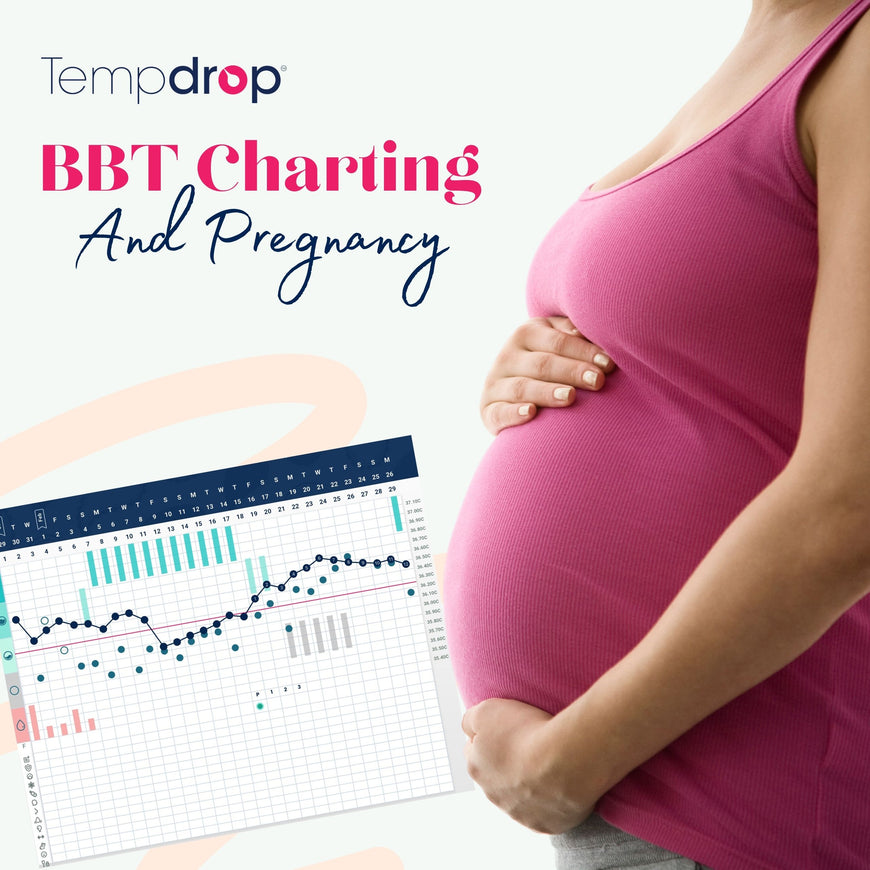Tracking your fertility is very helpful when trying to get pregnant by identifying
1) When it’s the right time to conceive
2) If there are any potential barriers to conceiving
Conception can only take place when we are ovulating, and ovulation happens only once each cycle. So knowing when you are ovulating is crucial when trying to conceive. Tracking our basal body temperature enables us to identify the approximate time of ovulation, the “fertility window” the special 5-7 days per cycle when sperm can stay alive in optimal conditions, and the 24-48 hours the egg can stay alive.
I highly encourage you to start charting your whole menstrual cycle and be in tune with when ovulation occurs. Fertility charting can substantially increase your chances to conceive, help to identify barriers to conceiving quickly, all the while having the benefit of being incredibly empowering.
So how do you identify pregnancy using temperatures?
Before ovulation, we experience slightly shifting basal body temperatures each day within a lower range of temperatures. After ovulation, temperatures shift upward, continuing in a higher range until you get your next period. This part of the cycle after ovulation is known as the luteal phase - which refers to the corpus luteum - the “leftover” from the egg released during ovulation produces progesterone for the remainder of the cycle.
The luteal phase is generally 10-16 days long and relatively stable, varying only by one or two days each cycle. Towards the end of the luteal phase, the withdrawal of hormones allows the uterine lining to shed (that is if conception hasn't taken place). This drop in hormones results in a decline in our temperature range as they return to their pre-ovulatory lower range. However, if we continue to see high temperatures past 18 days, it is a good sign that conception has occurred. Monitoring your luteal phase length with temperatures will help you know when to test and if you are truly "late" or have simply ovulated later than expected.
Using your fertility chart to optimize conception
Once ovulation has taken place, the egg only lives for approximately 24 hours. Because basal body temperature only rises after ovulation has taken place, you want to have intercourse before your temperature rise and maybe even include the day of your temperature rise.
To further increase your chances of getting pregnant, tracking your cervical mucus comes into play. Cervical mucus is a hydrogel secreted by your cervix. It is influenced by changing estrogen and progesterone levels, and it nourishes sperm, keeping them alive and ready for action for up to five days.

Shortly after menstruation, estrogen levels begin to rise as the developing follicle, where the egg is growing, matures. When estrogen reaches its peak levels, ovulation is triggered, and the egg is released. As estrogen rises, your cervical mucus becomes increasingly more sperm-friendly. Close to ovulation, we experience what is called peak-type mucus. This mucus is stretchy, clear or partly clear, and has a slippery or watery sensation.
Timing intercourse for days where you experience this type of mucus allows sperm to stay alive long enough to fertilize the egg when it is released.
Identifying barriers to a healthy conception
We can also identify potential barriers to a healthy conception using our fertility charting.
Indicators that barriers may exist can be:
- Whether you have enough quality cervical mucus. You can evaluate this by tracking the quantity and type of your mucus daily.
- The length of your luteal phase. An adequate luteal phase length indicates whether there are sufficient progesterone levels, necessary for ensuring conception. Generally, a luteal phase of 10-16 days is ideal.
- A weak temperature shift, with subsequent temperatures hovering close to the cover line. This can also be an indicator of low progesterone.
- Irregular ovulation. Ovulating regularly is an essential element to check if you are struggling to conceive. By tracking your cycles, you can see each cycle if and when ovulation is taking place.
When conception occurs
When you have successfully conceived, your basal body temperatures can give you a more accurate picture of when conception occurred. How? You will have the approximate time of ovulation (1-3 days before your temperature shifts upwards), instead of a guess that due date calculations use. To determine a more accurate due date, add nine months to your temperature shift and subtract seven days from that date.
Taking control of your health and fertility.
Your fertility chart is an incredible tool that allows you to have a window into your fertility and overall health. By tracking your cycle, you can rule out any potential barriers to conceiving, or troubleshoot what may be the root cause of any infertility issues. With the information from your fertility chart, you can take your unique cycle data to a reproductive health practitioner to work towards a potential treatment much faster.

Nathalie Daudet is a social worker and FEMM instructor based in Winnipeg, Canada. She discovered fertility awareness after searching high and low for a non-hormonal method of birth control. After learning the magic of fertility awareness and the gift of body literacy, she decided to pursue formal fertility awareness training and share the knowledge of fertility awareness with women looking for a natural birth control option. Fertility Awareness Project is the hub for Nathalie’s FEMM classes in both group and individual formats, online and in-person in Winnipeg. If you love this post and would like to thank Nathalie, shop Tempdrop with Nathalie's unique referral link.

